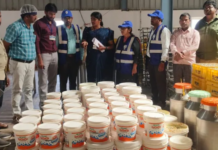Minister of Agriculture and Food Processing Industries Shri Sharad Pawar today affirmed that the ambitious National Dairy Plan with an investment of Rs. 2200 crore will help to meet the rising demand of milk and milk products. It is estimated that the country will need 150 million tonnes milk by 2016-17.
Speaking at the India Dairy Summit 2013, Shri Pawar said that India ranked first among the milk producing nations with 128 million tonnes of production at present. For raising this by 22 million tonnes within this Plan, the strategy would be to enhance productivity, strengthen and expand village level infrastructure for milk procurement access to market.
Further explaining the strategy the Minister said: “The strategy involves increasing the genetic potential of bovines, producing the required number of quality bulls, producing superior quality frozen semen, promoting scientific management practices and adopting adequate bio-security measures for effective control of diseases. The scheme is implemented through NDDB and the end implementing agencies. NDP-I focuses on 14 major milk producing States – Uttar Pradesh, Punjab, Haryana, Gujarat, Rajasthan, Madhya Pradesh, Bihar, West Bengal, Maharashtra, Karnataka, Tamil Nadu, Andhra Pradesh, Orissa and Kerala, which account for over 90% of the country’s milk production. Implementation of NDP will however benefit all other states in terms of benefits accruing from availability of quality bulls and semen and demonstration of improved management practices.”
The Minister also emphasised the need to bring more farmers into the organized sector: “The credit of rapid expansion of India’s dairy sector goes to the cooperative movement. Today about 15 million farmers have been organized under the ambit of 1.5 lakh village level dairy cooperative societies in the country. India has built a substantial capacity for procurement, processing and marketing of milk and milk products, both in cooperative and private sector. At present about 30% of marketable surplus of milk is marketed by the organised sector. We need to target that by the end of this five year plan, at least 50% of the milk in the country is handled by organised sector. Both the Private and Cooperative sectors needs to come forward and invest in creating the chilling and cold chain facility to handle milk to be procured from the farmers so as to utilize the opportunity created by the growing demand for milk and milk products in the country.”
On the role of the private sector and the need to ensure remunerative prices, Shri Pawar said: “The private sector dairy industry has an important role in enhancing sustainability of dairy sector. Currently, more than 50% of marketable surplus milk is handled by private sector. But in most of the cases, the industry adopts a strategy which may not be conducive to encourage farmers to sustain productivity. We have observed that during flush season, the dairy industry, particularly in private sector reduces procurement and also reduces procurement price, sometimes to a level which is uneconomical for farmers. In order to achieve sustainable development of dairy sector, it is necessary to adopt a consistent strategy which would benefit both farmers and consumers. During 2012-13, this problem was acute in some of the States. Probably this has prompted some States to provide price incentive to farmers on milk supplied to cooperatives to mitigate increased cost of production. But this is not a desirable trend, since it is the responsibility of the dairy industry to provide remunerative prices to farmers. Farmers are also required to be assisted with quality extension services to reduce cost of production and improve productivity by adopting improved practices like providing balanced ration, taking care of micronutrient deficiency through area specific mineral mixtures and other scientific management practices. We need to ensure that extension and marketing services are provided to farmers through the dairy industry in cooperative and private sector.” — CCI Newswire
































